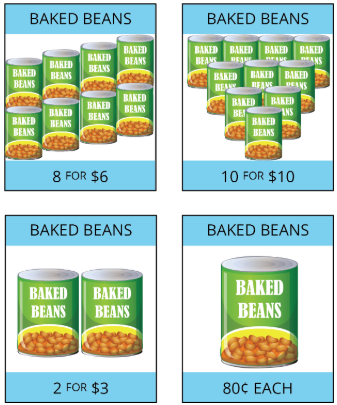17.1: Comparing Speeds and Prices
- Page ID
- 39945
Lesson
Let's compare some speeds and some prices.
Exercise \(\PageIndex{1}\): Closest Quotient
Is the value of each expression closer to \(\frac{1}{2}, 1,\) or \(1\frac{1}{2}\)?
- \(20\div 18\)
- \(9\div 20\)
- \(7\div 5\)
Exercise \(\PageIndex{2}\): More Treadmills
Some students did treadmill workouts, each one running at a constant speed. Answer the questions about their workouts. Explain or show your reasoning.
- Tyler ran 4,200 meters in 30 minutes.
- Kiran ran 6,300 meters in hour.
- Mai ran 6.3 kilometers in 45 minutes.
- What is the same about the workouts done by:
- Tyler and Kiran?
- Kiran and Mai?
- Mai and Tyler?
- At what rate did each of them run?
- How far did Mai run in her first 30 minutes on the treadmill?
Are you ready for more?
Tyler and Kiran each started running at a constant speed at the same time. Tyler ran 4,200 meters in 30 minutes and Kiran ran 6,300 meters in \(\frac{1}{2}\) hour. Eventually, Kiran ran 1 kilometer more than Tyler. How much time did it take for this to happen?
Exercise \(\PageIndex{3}\): The Best Deal on Beans
Four different stores posted ads about special sales on 15-oz cans of baked beans.
- Which store is offering the best deal? Explain your reasoning.

- The last store listed is also selling 28-oz cans of baked beans for $1.40 each. How does that price compare to the other prices?
Summary
Diego ran 3 kilometers in 20 minutes. Andre ran 2,550 meters in 17 minutes. Who ran faster? Since neither their distances nor their times are the same, we have two possible strategies:
- Find the time each person took to travel the same distance. The person who traveled that distance in less time is faster.
- Find the distance each person traveled in the same time. The person who traveled a longer distance in the same amount of time is faster.
It is often helpful to compare distances traveled in 1 unit of time (1 minute, for example), which means finding the speed such as meters per minute.
Let’s compare Diego and Andre’s speeds in meters per minute.
| distance (meters) | time (minutes) |
|---|---|
| \(3,000\) | \(20\) |
| \(1,500\) | \(10\) |
| \(150\) | \(1\) |
| distance (meters) | time (minutes) |
|---|---|
| \(2,550\) | \(17\) |
| \(150\) | \(1\) |
Both Diego and Andre ran 150 meters per minute, so they ran at the same speed.
Finding ratios that tell us how much of quantity \(A\) per 1 unit of quantity \(B\) is an efficient way to compare rates in different situations. Here are some familiar examples:
- Car speeds in miles per hour.
- Fruit and vegetable prices in dollars per pound.
Glossary Entries
Definition: Unit Price
The unit price is the cost for one item or for one unit of measure. For example, if 10 feet of chain link fencing cost $150, then the unit price is \(150\div 10\), or $15 per foot.
Practice
Exercise \(\PageIndex{4}\)
Mai and Priya were on scooters. Mai traveled 15 meters in 6 seconds. Priya travels 22 meters in 10 seconds. Who was moving faster? Explain your reasoning.
Exercise \(\PageIndex{5}\)
Here are the prices for cans of juice that are the same brand and the same size at different stores. Which store offers the best deal? Explain your reasoning.
Store X: 4 cans for $2.48
Store Y: 5 cans for $3.00
Store Z: 59 cents per can
Exercise \(\PageIndex{6}\)
Costs of homes can be very different in different parts of the United States.
- A 450-square-foot apartment in New York City costs $540,000. What is the price per square foot? Explain or show your reasoning.
- A 2,100-square-foot home in Cheyenne, Wyoming, costs $110 per square foot. How much does this home cost? Explain or show your reasoning.
Exercise \(\PageIndex{7}\)
There are 33.8 fluid ounces in a liter. There are 128 fluid ounces in a gallon. About how many liters are in a gallon?
- \(2\)
- \(3\)
- \(4\)
- \(5\)
Is your estimate larger or smaller than the actual number of liters in a gallon? Explain how you know.
(From Unit 3.2.3)
Exercise \(\PageIndex{8}\)
Diego is 165 cm tall. Andre is 1.7 m tall. Who is taller, Diego or Andre? Explain your reasoning.
(From Unit 3.2.2)
Exercise \(\PageIndex{9}\)
Name an object that could be about the same length as each measurement.
- 4 inches
- 6 feet
- 1 meter
- 5 yards
- 6 centimeters
- 2 millimeters
- 3 kilometers
(From Unit 3.2.1)

